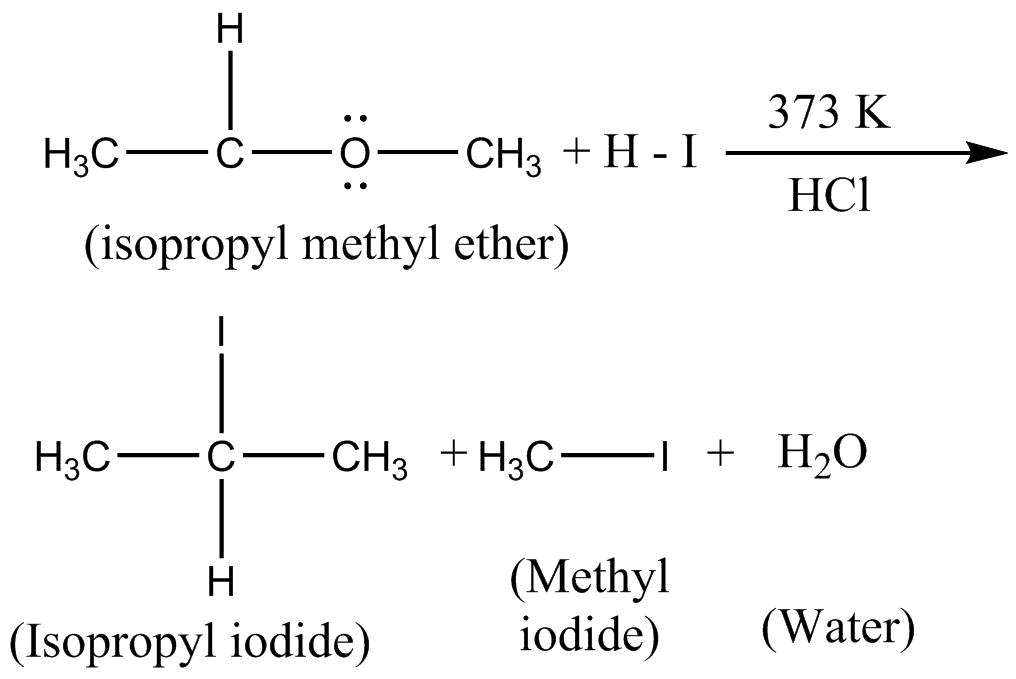
Answer
422.7k+ views
Hint: $HI$ reacts with isopropyl methyl ether by undergoing substitution reaction. Substitution reaction is a reaction in which one functional group of the compound gets substituted with another group. Substitution reaction is of two types i.e. nucleophilic substitution reaction and electrophilic substitution reaction.
Complete step by step answer:
When isopropyl methyl ether reacts with cold $HI$ , it undergoes $S{N_2}$ reaction. In $S{N_2}$ reaction, the elimination of the leaving group and attack of the nucleophile occurs simultaneously.
In the reaction, isopropyl methyl ether (mixed ether) or reacting with cold $HI$ yields methyl iodine (lower alkyl halide) and isopropyl alcohol (higher alcohol), as show in the reaction below:


The ${(C{H_3})_2} - CH - O - $ is formed and $H$ from $H - I$ attaches to it. Whereas, the $I$ from $H - I$ attaches to $ - C{H_3}$ (leaving group)
Additional Information:
When isopropyl methyl ether is reacted with hot $HI$ instead of cold $HI$ , following reaction takes place at $373K$

Hence, isopropyl iodine, methyl iodine and water are obtained upon the reaction of isopropyl methyl ether with hot conc $HI$ .
So, the correct answer is Option B.
Note: $S{N_2}$ reaction is a common reaction in organic chemistry. In this reaction one bond is broken and another bond is formed simultaneously. In this reaction, the nucleophile attacks from the back side of the substrate, to break the carbon-leaving group bond. It then forms a new carbon-nucleophile bond. For observing the maximum rate of $S{N_2}$ reaction, the substrate must be least hindered. Therefore, the primary and methyl substrate show maximum rate of $S{N_2}$ reaction, the secondary substrates have a lower rate of reaction and the tertiary substrate do not participate at all in the $S{N_2}$ reaction because of large amount of steric hindrance in them.
Complete step by step answer:
When isopropyl methyl ether reacts with cold $HI$ , it undergoes $S{N_2}$ reaction. In $S{N_2}$ reaction, the elimination of the leaving group and attack of the nucleophile occurs simultaneously.
In the reaction, isopropyl methyl ether (mixed ether) or reacting with cold $HI$ yields methyl iodine (lower alkyl halide) and isopropyl alcohol (higher alcohol), as show in the reaction below:


The ${(C{H_3})_2} - CH - O - $ is formed and $H$ from $H - I$ attaches to it. Whereas, the $I$ from $H - I$ attaches to $ - C{H_3}$ (leaving group)
Additional Information:
When isopropyl methyl ether is reacted with hot $HI$ instead of cold $HI$ , following reaction takes place at $373K$

Hence, isopropyl iodine, methyl iodine and water are obtained upon the reaction of isopropyl methyl ether with hot conc $HI$ .
So, the correct answer is Option B.
Note: $S{N_2}$ reaction is a common reaction in organic chemistry. In this reaction one bond is broken and another bond is formed simultaneously. In this reaction, the nucleophile attacks from the back side of the substrate, to break the carbon-leaving group bond. It then forms a new carbon-nucleophile bond. For observing the maximum rate of $S{N_2}$ reaction, the substrate must be least hindered. Therefore, the primary and methyl substrate show maximum rate of $S{N_2}$ reaction, the secondary substrates have a lower rate of reaction and the tertiary substrate do not participate at all in the $S{N_2}$ reaction because of large amount of steric hindrance in them.
Recently Updated Pages
Write the IUPAC name of the given compound class 11 chemistry CBSE

Write the IUPAC name of the given compound class 11 chemistry CBSE

Write the IUPAC name of the given compound class 11 chemistry CBSE

Write the IUPAC name of the given compound class 11 chemistry CBSE

Write the IUPAC name of the given compound class 11 chemistry CBSE

Write the IUPAC name of the given compound class 11 chemistry CBSE

Trending doubts
Fill the blanks with the suitable prepositions 1 The class 9 english CBSE

Which are the Top 10 Largest Countries of the World?

How do you graph the function fx 4x class 9 maths CBSE

Distinguish between the following Ferrous and nonferrous class 9 social science CBSE

The term ISWM refers to A Integrated Solid Waste Machine class 10 social science CBSE

The Equation xxx + 2 is Satisfied when x is Equal to Class 10 Maths

Difference between Prokaryotic cell and Eukaryotic class 11 biology CBSE

Which is the longest day and shortest night in the class 11 sst CBSE

In a democracy the final decisionmaking power rests class 11 social science CBSE




